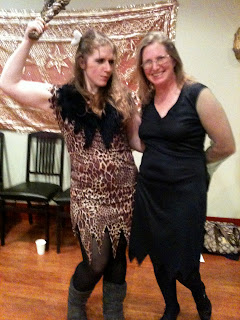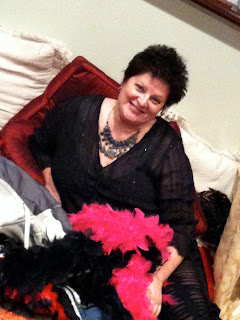Although most of you are not law enforcement officers, each of you still has multiple stress factors in your lives in many forms including: CrossFit, daily commute to and from work, bills, gas station attendants, checking Facebook, updating status, checking email, managing employees, answering to your boss, project deadlines, creating spreadsheets, proof reading spreadsheets, waiting in the drive-thru at Starbucks and choosing black coffee or an extra hot, no foam, hazelnut latte, finding matching Tupperware containers & lids, LAUNDRY!, diapers, story time, dinner, meal preparation, getting though the latest People magazine and finally - ME! CHUCK!...I think that's enough.
These are common stress factors that most of us have in life. How can CrossFit, known to be one of the most brutal strength & conditioning programs on the planet, help alleviate anything in your life?
The following is an excerpt from a recent article by Dr. Len Kravitz & Maria-Victoria Montes in the February 2011 Idea Fitness Journal.
The following is an excerpt from a recent article by Dr. Len Kravitz & Maria-Victoria Montes in the February 2011 Idea Fitness Journal.
The Buffering Effect of Exercise on Stress
The most comprehensive recent review on the health benefits of exercise and physical activity comes from the Physical Activity Guidelines Advisory Committee Report, 2008 published that year by the U.S. Department of Health and Human Services. This report concluded that physical activity can protect against feelings of distress, defend against symptoms of anxiety, guard against depressive symptoms and the development of major depressive disorder and enhance psychological well-being. Additionally, exercise bouts of 30 minutes, but not longer than 60 minutes appear to have the best "stress-reducing" benefits (thank God for Fran and Fight Gone Bad!). There does not appear to be a differential effect based on the type of exercise (e.g., running swimming, cycling, elliptical training, etc.). As to exercise intensity, the Physical Activity Guidelines report indicates that moderate to vigorous physical activity (with regular participation) reduces stress better than low-intensity activity. Yes to WODs!
There are definitely positive adaptations to a regular strength & conditioning program and I'm sure you've heard all of them. The following stress management suggestions are from an article in IDEA by Melissa Stoppler, MD (2008), and can be found on www.medicinenet.com.
1. Exercise. Provides a distraction from stressful situations, as well as an outlet for frustration. In many ways it acts as a buffer to the overflow of hormones that accumulate from daily stress. There is little I can focus on when suffering through one of Dan or Lindsay's WODs, and I like it that way.
2. Meditation. Stoppler suggests that in a medictactive state, deep centering occurs with a focusing on the core of our being; this allows for quieting of the mind and emotions, which helps relax tension in the body. During meditation, the brain enters an area of functioning similar to sleep, but with added benefits that we cannot achieve in any other state such as the release of certain hormones that promote health. Perfect advertising op for yoga at CFH - 5:45 AM Thursday.
3. Progressive Muscle Relaxation. Progressive muscle relaxation involves tightening and then releasing of the muscles in the body (in succession). If one of us trainers has an extra minute or two, we'd be happy to give you a quick stretch in the hammies, shoulders and quad/hip flexors.
4. Time Management. One of the biggest causes of stress is poor time management. Good organization of time is central to effective stress control. By learning to prioritize tasks and avoid overcommitment, we avoid the stress of being over-scheduled, with too many responsibilities at work and in the family. Stoppler recommends using a daily planner and calendar to prioritize tasks and stay focused on those at hand; identifying regular time-wasting activities (Facebook is NOT time-wasting!) and eliminating them; and banishing procrastination.
5. Support Systems. According to Stoppler, studies indicate that people with a positive and helpful social structure - consisting of friends, family, loved ones and pets (and CrossFitters!) - experience fewer stress related symptoms. Where's Brad anyway?
6. Healthy Food & Drink. Dehydration and hunger tend to provoke feeling of stress and anxiety (When I get hungry I get so angry, but when I'm dehydrated, I feel depressed. Weird, I know). Drinking plenty of water throughout the day and eating a nutritious diet can help reduce stress. At least 100 ounces a day for most people.
7. Posture Check. Shelly has GREAT posture. I have moderately accurate posture. Shelly does a lot more yoga than I do too. I've was actually diagnosed with juvenile scoliosis when I was 10. Since then, I've had to work on standing straight and keeping my shoulder back, down and relaxed. When I was little, I was really self conscious of my massively developed chest. I would try to hide it by hunching over. Now, I hunch over because I'm tired of people trying to touch it and grope me all the time (kidding). However, poor standing and sitting posture lead to muscle tension, pain and increased stress. Stress management strategies include checking posture regularly at work and during daily activities; avoiding stooping, slumping and repetitive-strain activities/movements; and developing healthily sitting, standing and working environments.
8. Recharging. Recharging means setting aside some time each day for energizing the mind. This is hard for many because there is no extra time in the day. Normally on my commute to work, I'll turn the radio off and find a way to just let my mind either wander (which isn't too hard) or meditate on one intention (which is actually very difficult for me). I like to listen to audiobooks on my way to work which resonate with me.
9. Speaking slowly. Yea, who knew? Speaking slowly can be helpful in stressful situations. When we speak slowly, we think more clearly and often respond much more reasonably to a stressful situation. Like my grandmother Degatano always said "Charlie, you always catch more bees with honey than vinegar."
10. Visualization. Gratifying or relaxing images calm the mind and body. Visualizing a soothing setting (e.g., outdoors in a meadow, by the ocean, along a mountain stream) while breathing slow, controlled way brings about a state of calm and relaxation. Like I always say, "The slower you go, the fast you'll get there." (I think I stole that from someone, but I don't remember who)
And if none of this is working for you, I'll always recommend my default stress reliever.
4 ounces Spicy V-8
4 ounces Monopolowa
Splash of Worcestershire
Dash of pepper
Celery stick
Spanish
season rim to task
And 1 Ashton VsG cigar
Sounds good, doesn't it?
Reference
Kravitz, Len & Montes, Maria-Victoria. 2011. Unraveling the stress eating obesity knot. IDEA Fitness Journal, 44-50
And if none of this is working for you, I'll always recommend my default stress reliever.
4 ounces Spicy V-8
4 ounces Monopolowa
Splash of Worcestershire
Dash of pepper
Celery stick
Spanish
season rim to task
And 1 Ashton VsG cigar
Sounds good, doesn't it?
Reference
Kravitz, Len & Montes, Maria-Victoria. 2011. Unraveling the stress eating obesity knot. IDEA Fitness Journal, 44-50


























